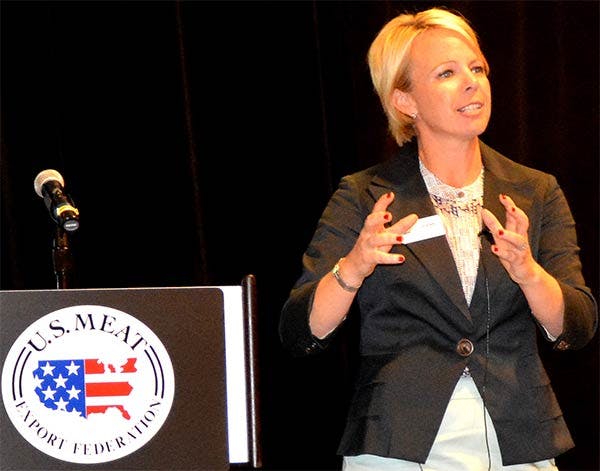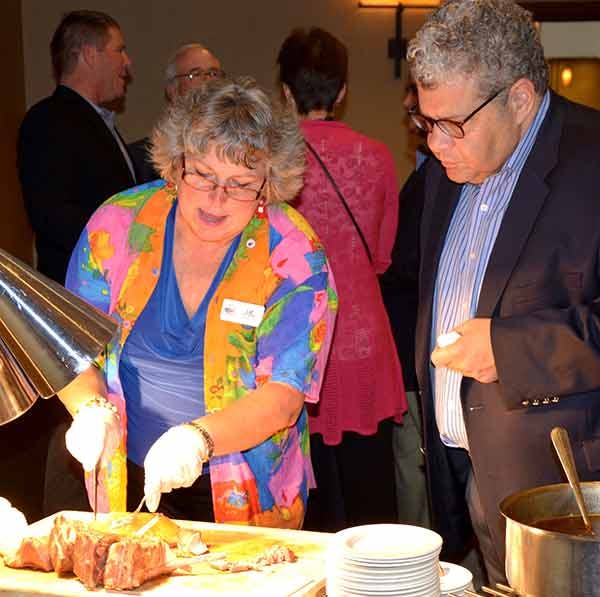USMEF Board Meeting Underway in San Antonio
The USMEF Board of Directors Meeting kicked off in San Antonio, Texas, Wednesday afternoon. USMEF Chair Leann Saunders opened the event by providing members with an update on “Project 40” – a USMEF Executive Committee initiative designed to build on nearly 40 years of success and make USMEF a stronger organization going forward.

Leann Saunders kicks off the USMEF Board of Directors Meeting in San Antonio
Saunders noted that feedback received during a comprehensive survey of the USMEF membership and other interviews conducted as part of Project 40 has been overwhelmingly positive. However, some areas were identified in which members feel the organization could be more proactive and strive for improvement.
“I want you to know that the volunteer leadership and staff of USMEF take these recommendations very seriously,” Saunders said. “USMEF is not a complacent organization. We are always striving for excellence, and will work collectively to move toward positive change. USMEF has achieved a high level of member satisfaction, yet we are always looking to continuously improve.”
CattleFax CEO Randy Blach was Wednesday’s keynote speaker, providing attendees with an informative and enlightening look at the current state of global protein demand, production and trade. He opened with a favorable update on spring planting progress.
“The past few years we’ve put more corn into production and gotten through a tough drought situation, and we’re now producing record-large corn crops,” he said. “And this spring, 85 percent of the corn crop is in the ground. We’re off to a great start, headed for a big corn crop. And on the soybean side we have a similar situation, with huge growth in our soybean output.
“For those of you who are (corn and soybean) producers, I’m not going to pull any punches – we’re going to be at break-even pricing for the next several years. We had great run in our farming operations from 2005 through 2012 or 2013, but now we’re in a period of much, much narrower margins.”

Keynote speaker Randy Blach
Blach explained that one of the most effective ways of restoring healthier margins to the U.S. farming sector is to expand international sales of high-quality protein, essentially exporting more corn and soybeans in a value-added form. But he emphasized that the global marketplace for red meat is fiercely competitive, so it is important to reduce trade barriers that limit market access for U.S. suppliers and increase their costs.
“That’s why the discussion we are having here today is so critical,” he said. “We have to improve our level of access to international markets for U.S. beef and pork, and it needs to be a high priority.”
Blach also noted that herd expansion has finally gained traction among U.S. cattle producers.
“Heifers are going back into the cow herd,” he explained, “The herd is growing at a rapid pace – and it needed to. If we didn’t respond as an industry to this economic signal to grow the nation’s cow herd, beef would have moved from the center of the plate to the edge of the plate.”
Blach also cautioned beef and pork producers about the potential impact of avian influenza, which has caused the U.S. poultry industry to lose access to some international markets. He noted that the number of birds lost to the disease will not come close to offsetting the upward trend in poultry production, meaning that there will likely be surplus of poultry confined to the domestic market over the next several months.

A panel discussion focused on marketing underutilized beef, pork and lamb cuts in Mexico, the Caribbean and the ASEAN region
USMEF President and CEO Philip Seng also spoke to attendees Wednesday, addressing many of the current challenges facing U.S. beef, pork and lamb exports. He noted that the West Coast port congestion that slowed exports earlier this year has been largely resolved, but the industry is still feeling some impact. Competitors – especially European pork suppliers and exporters of Australian beef whose price advantage was already buoyed by weakened currencies – were quick to capitalize on this situation in key Asian markets. He also discussed recently implemented free trade agreements that have altered the competitive landscape in several of these markets, lowering tariff rates for beef and pork supplied by several competitors.
Seng challenged the industry to be more proactive in addressing potential market access barriers related to foreign animal diseases, noting that U.S. exports are still held back to some degree by the BSE case detected in December 2003.
“My suggestion would be that we reach out to the governments of these countries that we’re exporting 80 percent of our products to – that’s probably six or seven governments – and have a conversation about these issues,” Seng said. “Not with our hair on fire, not when we have a crisis – that’s not a good time to talk. But these countries need our product, and we need to have access to them. So what can we do to ensure that we don’t have a repeat of what happened with BSE?”
Seng noted that USMEF is well-known for its market development efforts, which have been successful in expanding demand for U.S. red meat in many countries and regions across the world. But he explained that competition is now so intense that traditional market development models may no longer suffice in many of these markets.

Caribbean representative Elizabeth Wunderlich discusses lamb preparation methods with Sami Rizk, president of Mirasco Inc.
“Market development and looking for new markets – those are still important strategies,” Seng said. “But that takes a lot of time and resources, for returns that are not always what we might hope for. I would say that the key strategy USMEF is invoking today is displacement. We have to displace the competition, because that’s exactly what our competition is trying to do to us.”
Wednesday’s general session concluded with a panel discussion in which USMEF representatives from Mexico, the Caribbean and the ASEAN region provided an inside look at marketing strategies designed to add value to underutilized cuts of U.S. beef, pork and lamb. The panel offered insights into the markets to which these cuts are targeted, how they are prepared and the methods used to bring them to the attention of chefs, retailers, distributors and consumers.
One example provided by Elizabeth Wunderlich, USMEF Caribbean representative, is promotion of U.S. lamb belly, which is designed to capitalize on the popularity of pork belly and gain exposure for the high-quality attributes of American lamb.
USMEF ASEAN Director Sabrina Yin explained that cuts such as the beef hind shank are gaining popularity in her region – often being cut into cubes for stew, sliced thin for stir-fry or braised and presented as cold meat slices. Beef short plate, which has been commonly used in stews and soups, is now being touted for use in stir-fry dishes.
Yin said the new approaches for these beef cuts are promoted at chef demonstrations and at trade shows.
“We are also creating market opportunities through promotions in retail and the hotel and restaurant industries,” she said. “We provide importers and their customers with fact sheets on these U.S. beef cuts and give them new menu ideas.”
German Navarette, USMEF-Mexico corporate chef, has launched efforts in Mexico to educate chefs and other foodservice professionals about new methods of preparing beef brisket. In Mexico, brisket has traditionally been cubed or chopped in small pieces for stocks and stews, Navarette explained. But he is familiarizing chefs with slower cooking methods that allow them to work with whole and sliced briskets.
Pork shoulder was often given the same treatment in Mexico, but chefs are now encouraged to prepare pork shoulder in new and innovative ways.
Prior to Wednesday’s launch of the USMEF Board of Directors Meeting, USMEF hosted an informational session for members representing the Texas Beef Council, Texas Farm Bureau, Texas Cattle Feeders Association and the Texas and Southwest Cattle Raisers Association, as well as other meat and livestock industry guests from the San Antonio area.
USMEF staff provided updates on opportunities and challenges in several key international markets, and offered examples of how support from these Texas-based organizations is being used to expand demand for U.S. red meat.
“USMEF certainly appreciates the excellent support we receive from the state of Texas,” Seng said. “There is a lot of history here dating all the way back to the founding of the organization, and many industry leaders who have been active in USMEF for decades.”
Thursday’s Board of Directors Meeting agenda features a panel discussion on the role of branded products in international markets, followed by meetings of USMEF’s standing committees: the Pork and Allied Industries Committee, Beef and Allied Industries Committee, Exporter Committee and the Feedgrain and Oilseed Caucus.
